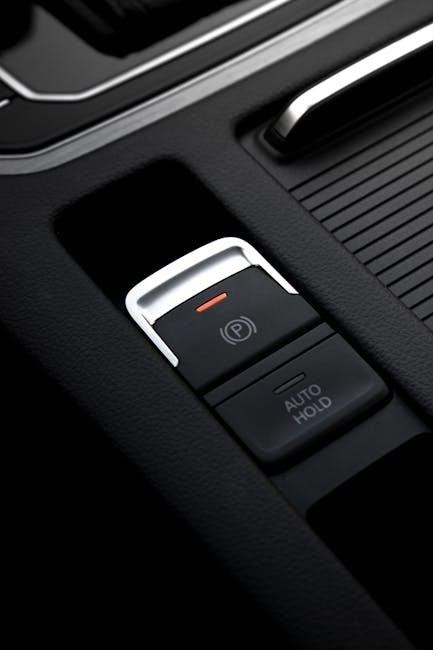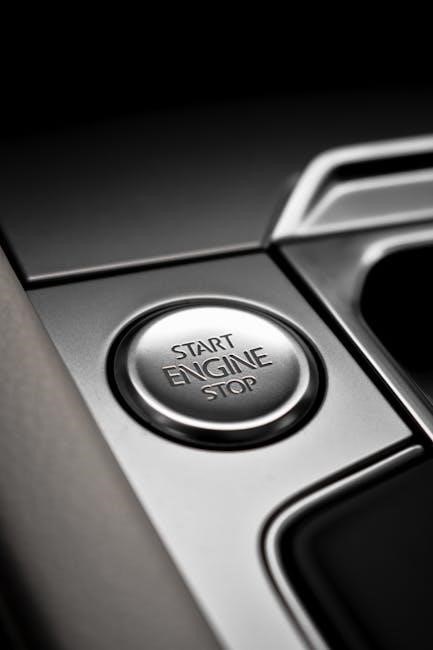The Cat P5000 Throttle Control Switch is a vital component regulating engine speed and performance in heavy machinery, ensuring smooth operation and safety in industrial environments.
Overview of the Cat P5000 Throttle Control Switch
The Cat P5000 Throttle Control Switch is a critical component designed to regulate engine speed and performance in heavy machinery. It operates by sending electrical signals to the engine’s control module, which adjusts fuel delivery based on operator input. This switch is integral to both manual and automatic systems, ensuring precise control over acceleration and deceleration. Its design incorporates key components like the accelerator pedal, throttle position sensor (TPS), and engine control unit (ECU), working in harmony to maintain optimal performance. Proper functioning of this switch is essential for smooth machinery operation, safety, and productivity in industrial environments.
Importance of the Throttle Control Switch in Forklift Operations
The Cat P5000 Throttle Control Switch plays a pivotal role in ensuring smooth and efficient forklift operations. It directly impacts safety, productivity, and operational precision by regulating engine speed and response. A malfunctioning switch can lead to erratic acceleration, unexpected stops, or complete loss of control, posing significant safety risks. Proper functioning ensures seamless communication between the operator and the machine, enabling precise load handling and navigation. Regular maintenance of this component is essential to prevent operational disruptions and maintain workplace safety, making it a cornerstone of reliable forklift performance in industrial settings.
Common Issues with the Cat P5000 Throttle Control Switch
Common issues include erratic throttle response, complete lack of response, and intermittent operation, often caused by wiring faults, dirty sensors, or switch malfunctions, impacting performance.
Erratic Throttle Response
Erratic throttle response in the Cat P5000 occurs when the switch sends inconsistent signals to the engine control module, causing unpredictable speed fluctuations. This issue often stems from faulty wiring, dirty or malfunctioning sensors, or worn-out switch contacts. Over time, dirt and debris can accumulate on the switch, disrupting electrical connections. Additionally, a failing throttle position sensor (TPS) may miscommunicate with the engine, leading to irregular performance. To address this, inspect and clean the switch, test wiring for damage, and replace faulty components. Using a multimeter to check continuity and voltage can help pinpoint the root cause, ensuring precise repairs. Regular maintenance is key to preventing such issues.
Complete Lack of Response
A complete lack of response from the Cat P5000 Throttle Control Switch indicates a severe disruption in signal transmission to the engine. This issue can arise from significant electrical failures, such as open circuits or shorted wires, or a defective switch itself. Additionally, corrosion or dirt in the connectors may prevent proper communication between the switch and the engine control module. To resolve this, inspect wiring for damage, clean connections, and test the switch for continuity using a multimeter. If the switch is found to be faulty, replacement is necessary to restore functionality and ensure safe operation. Prompt action is crucial to avoid extended downtime.
Intermittent Operation
Intermittent operation of the Cat P5000 Throttle Control Switch is characterized by sporadic or unpredictable responsiveness. This issue often stems from loose or corroded electrical connections, faulty wiring, or a malfunctioning throttle position sensor (TPS). Dirt or debris accumulation on the switch or its contacts can also disrupt signal transmission. To diagnose, inspect the wiring harness for damage, clean the connections, and test the TPS for proper voltage output. If the problem persists, the switch or sensor may need replacement. Addressing intermittent issues promptly is essential to prevent sudden operational failures during critical tasks. Regular maintenance can help mitigate such problems.

Troubleshooting Tools and Preparation
Essential tools for troubleshooting the Cat P5000 throttle control switch include a multimeter, wrench set, and electrical connectors. Always disconnect power and ensure safety before starting.
Essential Tools for Troubleshooting
To diagnose and repair the Cat P5000 throttle control switch, essential tools include a multimeter for checking electrical continuity, a wrench set for removing components, and insulated pliers for handling wires safely. Additionally, screwdrivers, electrical connectors, and a torque wrench may be necessary for specific adjustments. Safety gear like gloves and safety glasses is crucial to protect against potential hazards. Having these tools ready ensures a systematic and efficient troubleshooting process, minimizing downtime and preventing further damage to the machinery.
Preparation Steps Before Starting Troubleshooting
Before troubleshooting the Cat P5000 throttle control switch, ensure the machine is on level ground and in neutral gear. Disconnect the power supply and engage the parking brake for safety. Gather all necessary tools and consult the service manual for specific instructions. Wear protective gear, including gloves and safety glasses. Review error codes if available and ensure all components are cool to avoid burns. This systematic preparation minimizes risks and ensures a focused diagnostic process, leading to efficient and effective troubleshooting of the throttle control switch.
Step-by-Step Troubleshooting Guide
This guide provides a detailed approach to diagnosing and resolving Cat P5000 throttle control switch issues, ensuring efficient problem-solving and minimal downtime for machinery operations.
Checking Electrical Connections and Wiring
Begin by inspecting all electrical connections and wiring related to the Cat P5000 throttle control switch. Ensure terminals are clean and free from corrosion. Look for signs of damage, such as frayed wires or loose connections, which can disrupt signal flow. Use a multimeter to test for continuity and voltage drops across the circuit. Secure any loose connections and replace damaged components to restore proper electrical flow. This step is crucial for identifying issues that may cause erratic or intermittent throttle response.
Testing the Throttle Control Switch for Continuity
To test the Cat P5000 throttle control switch for continuity, use a multimeter set to the ohms function. Connect the multimeter probes to the switch’s terminals and activate the switch to check for a closed circuit. If the multimeter shows continuity (low resistance), the switch is functioning properly. If there’s no continuity or inconsistent readings, the switch may be faulty. Consult the service manual for terminal configurations, as some switches have multiple terminals. This test identifies internal electrical failures, helping determine if replacement is necessary. Always disconnect power before testing to ensure safety and accurate results.
Inspecting the Throttle Position Sensor (TPS)
Inspecting the Throttle Position Sensor (TPS) is crucial for diagnosing issues with the Cat P5000 throttle control switch. Begin by ensuring the sensor is clean and free of debris, as dirt can disrupt signal transmission. Use a multimeter to verify the TPS’s electrical output, checking for smooth voltage transitions as the throttle moves. Inspect the sensor’s wiring and connections for damage or corrosion. If the TPS shows signs of physical wear or fails to provide accurate readings, replacement may be necessary. Proper TPS function is essential for maintaining precise throttle control and overall engine performance.

Repairs and Replacement
Repairs and replacement for the Cat P5000 throttle control switch involve identifying faulty components, cleaning or replacing damaged parts, and ensuring proper installation to restore optimal functionality.
When to Replace the Throttle Control Switch
The Cat P5000 throttle control switch should be replaced if it exhibits persistent malfunction despite troubleshooting. Key indicators include erratic or intermittent responses, complete lack of functionality, or failure to send proper signals to the ECM. If testing with a multimeter reveals no continuity or inconsistent resistance, replacement is necessary. Additionally, physical damage, excessive wear, or corrosion on the switch or wiring warrants immediate replacement to ensure safety and performance. Always use genuine Cat parts for compatibility and reliability, and consult the service manual for proper installation procedures to maintain optimal functionality and compliance with safety standards.
How to Clean and Maintain the Throttle Control Switch
Proper cleaning and maintenance of the Cat P5000 throttle control switch are essential for optimal performance. Start by disconnecting the power supply to ensure safety. Use an electrical contact cleaner to remove dirt, grease, and debris from the switch terminals and surrounding areas. Avoid using harsh chemicals or abrasive materials that could damage the components. After cleaning, allow the switch to dry completely before reconnecting it. Regularly inspect the wiring and connections for signs of wear or corrosion. Lubricate moving parts if necessary, and replace any damaged or corroded connectors. Scheduled maintenance helps prevent unexpected failures and ensures reliable operation, reducing the need for costly repairs and downtime. This routine upkeep is crucial for maintaining the switch’s efficiency and extending its lifespan, ensuring consistent control over engine speed and performance in demanding environments.

Maintenance Tips for Optimal Performance
Regularly clean the throttle control switch with an electrical contact cleaner to remove dirt and debris. Inspect wiring for wear and lubricate moving parts if needed.
Scheduled Maintenance Practices
Regular maintenance is essential to ensure the Cat P5000 Throttle Control Switch operates efficiently. Schedule periodic inspections every 500 hours of operation to check for wear, dirt, or corrosion. Clean the switch and its connections using an electrical contact cleaner to prevent signal interference. Inspect the wiring harness for signs of damage or fraying and replace any worn components promptly. Lubricate moving parts if necessary to maintain smooth operation. Additionally, test the throttle response monthly to identify potential issues early. Always refer to the service manual for specific maintenance intervals and procedures tailored to your Cat P5000 model.
Common Mistakes to Avoid During Troubleshooting
When troubleshooting the Cat P5000 Throttle Control Switch, avoid common pitfalls that could worsen the issue or lead to unnecessary repairs. Neglecting to disconnect power before inspecting the switch is a critical mistake, as it poses safety risks. Overlooking basic checks, such as examining wiring and connections, can delay problem identification. Using improper tools or failing to clean the switch with an electrical cleaner may damage components. Additionally, rushing through diagnostics without a systematic approach can lead to missed issues. Always follow a structured process and consult the service manual to ensure accurate and safe troubleshooting.
Understanding Costs and Budgeting
Budgeting for Cat P5000 Throttle Control Switch repairs involves considering replacement parts, labor costs, and maintenance fees. Plan ahead to avoid financial surprises and downtime.
Cost Factors for Repairs and Replacement
The cost of repairing or replacing the Cat P5000 Throttle Control Switch varies based on factors such as the price of replacement parts, labor charges, and the extent of damage. Genuine Cat parts are typically more expensive than aftermarket alternatives but ensure compatibility and durability. Additionally, if the issue stems from related components like the TPS or wiring, repair costs can escalate. Budgeting for regular maintenance can help prevent unexpected expenses, while opting for preventive measures may reduce long-term costs.
Budgeting for Maintenance and Repairs
Budgeting for repairs and maintenance of the Cat P5000 Throttle Control Switch requires allocating funds for parts, labor, and preventive care. Regular inspections and cleaning can prevent costly issues, while setting aside money for unexpected repairs ensures financial preparedness. Consider the cost of genuine Cat parts, which may be higher but offer better reliability. Additionally, budget for tools and technician fees if professional assistance is needed. By prioritizing preventive maintenance, you can extend the lifespan of the switch and avoid premature replacement, ultimately saving resources over time. A well-planned budget helps maintain operational efficiency and reduces downtime;

Seeking Professional Help
Seeking professional help is recommended for complex issues with the Cat P5000 Throttle Control Switch; Certified technicians offer thorough diagnostics and repairs, minimizing downtime and ensuring safety.
When to Consult a Certified Technician
If the Cat P5000 Throttle Control Switch issues persist after basic troubleshooting, consulting a certified technician is essential. They can handle complex diagnostics, wiring problems, and component replacements efficiently. Their expertise ensures proper repairs and safety, preventing further damage. Additionally, if error codes like E31 appear, indicating throttle system malfunctions, professional assistance is crucial to resolve the issue promptly and avoid operational downtime.
Resources for Further Assistance
For detailed guidance on troubleshooting the Cat P5000 Throttle Control Switch, consult the official Caterpillar service manual or visit their technical support website. Additional resources include forums like Forkliftactions, where experts and users share solutions. Authorized Cat dealerships offer genuine parts and repair services, while online marketplaces like eBay provide replacement switches. For hands-on assistance, contact Cat’s customer support hotline or local certified technicians. These resources ensure comprehensive support for resolving throttle control switch issues effectively.